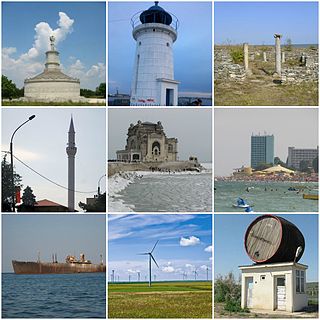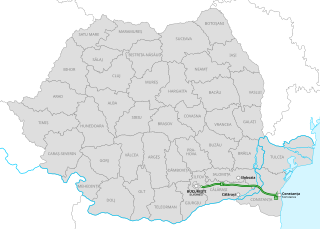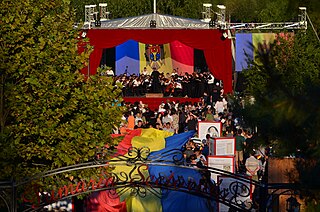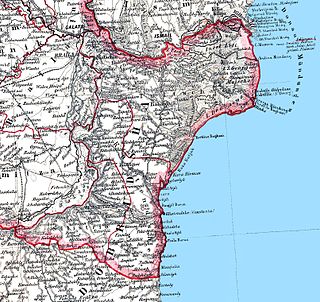
Northern Dobruja is the part of Dobruja within the borders of Romania. It lies between the lower Danube River and the Black Sea, bordered in the south by Southern Dobruja, which is a part of Bulgaria.

Dobruja or Dobrudja is a geographical and historical region in the Southeast Europe that has been divided since the 19th century between the territories of Bulgaria and Romania. It is situated between the lower Danube River and the Black Sea, and includes the Danube Delta, Romanian coast, and the northernmost part of the Bulgarian coast. The territory of Dobruja is made up of Northern Dobruja, which is a part of Romania, and Southern Dobruja, which is a part of Bulgaria.

Constanța, historically known as Tomis or Tomi, is a port city in the Dobruja historical region of Romania. As the country's fourth largest city and principal port on the Black Sea coast, Constanța is the capital of Constanța County. It is also the oldest continuously inhabited city in the region, founded around 600 BC, and among the oldest in Europe.

Constanța is a county (județ) of Romania on the border with Bulgaria, in the Dobruja region. Its capital city is also named Constanța.

Cernavodă is a town in Constanța County, Northern Dobruja, Romania with a population of 15,088 as of 2021.

Medgidia is a city in Constanța County, Northern Dobruja, south-eastern Romania.

The Danube–Black Sea Canal is a navigable canal in Romania, which runs from Cernavodă on the Danube river, via two branches, to Constanța and Năvodari on the Black Sea. Administered from Agigea, it is an important part of the waterway link between the North Sea and the Black Sea via the Rhine–Main–Danube Canal. The main branch of the canal, with a length of 64.4 km (40.0 mi), which connects the Port of Cernavodă with the Port of Constanța, was built in 1976–1984, while the northern branch, known as the Poarta Albă–Midia Năvodari Canal, with a length of 31.2 km (19.4 mi), connecting Poarta Albă and the Port of Midia, was built between 1983 and 1987.

The A2 motorway, also known as The Motorway of the Sun, is a motorway in Romania which links Bucharest with Constanța, a city-port on the shore of the Black Sea, where it merges after an interchange into the A4 motorway. It is 206 km long, and has been operational on its entire length since November 2012.

The Romanian Black Sea resorts, or the Romanian Riviera, stretch along the Black Sea coast from the Danube Delta at the northern end down to the Bulgarian Black Sea Coast in the south, along 275 kilometers of coastline.

Islam in Romania is followed by only 0.4 percent of population according to the 2022 Census, but has 700 years of tradition in Northern Dobruja, a region on the Black Sea coast which was part of the Ottoman Empire for almost five centuries. In present-day Romania, most adherents to Islam belong to the Tatar and Turkish ethnic communities and follow the Sunni doctrine. The Islamic religion is one of the 18 rites awarded state recognition.
Horia Agarici was a Romanian aviator and World War II flying ace.

Constanța Shipyard is the largest shipyard in Romania and one of the largest in Europe having a market share of 20% in the Black Sea basin. The shipyard has two drydocks, one used for the construction of ships up to 150,000 tonnes deadweight (DWT), and the second one used for the construction of ships up to 250,000 DWT, and two floating docks with a capacity of 8,000 tonnes and 15,000 tonnes.

The 9th Mechanized Brigade "Mărășești" is a mechanized infantry brigade of the Romanian Land Forces.

The Galați shipyard, formally Damen Shipyards Galați, is a shipyard located on the Danube in Galați, a city located in the Moldavia region of Romania. It was founded in 1893 as the G. Fernic et Co Mechanical constructions and iron and bronze foundry. In 1897, it was renamed as the G. Fernic et Co Shipyard.
Liga IV Constanța is the regional Liga IV football division for clubs in Constanța County, România, the fourth tier of the Romanian football league system. It is organized by the County Football Association and is competed amongst 18 teams, the winner is promoted to Liga III after a promotion play-off. The number of relegated team from the Liga IV – Constanța is variable and depends on the number of teams relegated from the Liga III.
Bukovina Day is a public holiday of Romania celebrated every 28 November that commemorates the decision of the General Congress of Bukovina to unite the region of Bukovina with the Kingdom of Romania on 28 November 1918.

The Romanian Language Day is a public holiday in Romania and Moldova celebrated every 31 August for the Romanian language. Romanian is a Romance language, being part of the same linguistic family as the French, Italian, Portuguese and Spanish languages.

Silistra Nouă County was a county (județ) of Romania, in Northern Dobruja, with its capital city first at Rasova, later at Cernavodă and finally at Medgidia. It was established on 13 November 1878 and abolished on 1 April 1879. After this, it was integrated into Constanța County, which became the only county in Romanian Dobruja along with Tulcea County. Silistra Nouă County was composed of two plăși ("districts"): Plasa Medgidia and Plasa Silistra Nouă. Despite its name, it did not include the city of Silistra.

The Giurgiu shipyard, formally Shipyard ATG Giurgiu, is a shipyard located on the Danube in Giurgiu, a city located in the Muntenia region of Romania.
Oltenia Day is a public holiday of Romania celebrated every 21 March that commemorates the entry into Bucharest on 21 March 1821 of the Romanian revolutionary Tudor Vladimirescu, who started the Wallachian uprising of 1821 in Oltenia, where he was born. The holiday was promulgated on 13 April 2017 by Law No. 65/2017 by the President of Romania Klaus Iohannis and published in the Monitorul Oficial on the same day. Previously, the project to establish the holiday had been approved by the Senate of Romania on 1 November 2016 and by the Chamber of Deputies of Romania on 21 March 2017. The holiday was first proposed by a group of 27 deputies and senators belonging to different Romanian political parties.

















